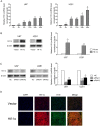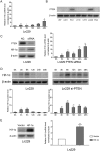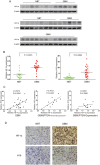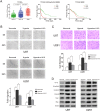Hypoxia induces H19 expression through direct and indirect Hif-1α activity, promoting oncogenic effects in glioblastoma
- PMID: 28327666
- PMCID: PMC5361208
- DOI: 10.1038/srep45029
Hypoxia induces H19 expression through direct and indirect Hif-1α activity, promoting oncogenic effects in glioblastoma
Abstract
H19 expression is elevated in many human tumors including glioblastomas, suggesting an oncogenic role for the long noncoding RNA; yet the upregulation of H19 in glioblastomas remains unclear. Here we report that hypoxia significantly stimulated H19 expression in glioblastoma cell lines, which was related to hypoxia-inducible factors 1α (Hif-1α). Hif-1α promoted H19 expression in U87 and U251 cells. Meanwhile PTEN is an advantageous factor to affect H19 expression, through attenuating Hif-1α stability. Hif-1α also positively correlates with H19 in human glioblastoma samples depending on PTEN status. ChIP and luciferase reporter assays showed that Hif-1α induced H19 transcription through directly binding to the H19 promoter. Furthermore, Hif-1α upregulated specific protein 1 (SP1) expression in glioblastomas cells in vitro and in vivo, and SP1 also strongly interacted with the H19 promoter to promote H19 expression under hypoxia. We also showed that H19 acts as a molecular sponge that binds miR-181d, relieving inhibition of β-catenin expression. Therefore, H19 participates in hypoxia-driven migration and invasion in glioblastoma cells. In summary, our results uncover the mechanisms that stimulate H19 expression under hypoxia to promote malignant effects in glioblastomas and suggest H19 might be a promising therapeutic target.
Conflict of interest statement
The authors declare no competing financial interests.
Figures







Similar articles
-
Hypoxia-inducible microRNA-224 promotes the cell growth, migration and invasion by directly targeting RASSF8 in gastric cancer.Mol Cancer. 2017 Feb 7;16(1):35. doi: 10.1186/s12943-017-0603-1. Mol Cancer. 2017. PMID: 28173803 Free PMC article.
-
Melatonin antagonizes hypoxia-mediated glioblastoma cell migration and invasion via inhibition of HIF-1α.J Pineal Res. 2013 Sep;55(2):121-30. doi: 10.1111/jpi.12052. Epub 2013 Mar 29. J Pineal Res. 2013. PMID: 23551342
-
LncRNA H19 promotes glioma angiogenesis through miR-138/HIF-1α/VEGF axis.Neoplasma. 2020 Jan;67(1):111-118. doi: 10.4149/neo_2019_190121N61. Epub 2019 Nov 26. Neoplasma. 2020. PMID: 31777264
-
Interplay of long non-coding RNAs and HIF-1α: A new dimension to understanding hypoxia-regulated tumor growth and metastasis.Cancer Lett. 2021 Feb 28;499:49-59. doi: 10.1016/j.canlet.2020.11.007. Epub 2020 Nov 18. Cancer Lett. 2021. PMID: 33217445 Review.
-
Hypoxia: The Cornerstone of Glioblastoma.Int J Mol Sci. 2021 Nov 22;22(22):12608. doi: 10.3390/ijms222212608. Int J Mol Sci. 2021. PMID: 34830491 Free PMC article. Review.
Cited by
-
Propofol suppresses hypoxia-induced esophageal cancer cell migration, invasion, and EMT through regulating lncRNA TMPO-AS1/miR-498 axis.Thorac Cancer. 2020 Sep;11(9):2398-2405. doi: 10.1111/1759-7714.13534. Epub 2020 Jul 8. Thorac Cancer. 2020. PMID: 32643321 Free PMC article.
-
Autologous blood transfusion augments impaired wound healing in diabetic mice by enhancing lncRNA H19 expression via the HIF-1α signaling pathway.Cell Commun Signal. 2018 Nov 20;16(1):84. doi: 10.1186/s12964-018-0290-6. Cell Commun Signal. 2018. PMID: 30458806 Free PMC article.
-
The role of hypoxia-induced long noncoding RNAs (lncRNAs) in tumorigenesis and metastasis.Biomed J. 2021 Oct;44(5):521-533. doi: 10.1016/j.bj.2021.03.005. Epub 2021 Mar 24. Biomed J. 2021. PMID: 34654684 Free PMC article. Review.
-
Crosstalk of lncRNA and Cellular Metabolism and Their Regulatory Mechanism in Cancer.Int J Mol Sci. 2020 Apr 22;21(8):2947. doi: 10.3390/ijms21082947. Int J Mol Sci. 2020. PMID: 32331347 Free PMC article. Review.
-
Long non-coding RNAs in bone metastasis: progresses and perspectives as potential diagnostic and prognostic biomarkers.Front Endocrinol (Lausanne). 2023 Apr 17;14:1156494. doi: 10.3389/fendo.2023.1156494. eCollection 2023. Front Endocrinol (Lausanne). 2023. PMID: 37143733 Free PMC article. Review.
References
-
- Jensen R. L. Hypoxia in the tumorigenesis of gliomas and as a potential target for therapeutic measures. Neurosurg Focus 20, E24 (2006). - PubMed
-
- Evans S. M. et al.. Hypoxia is important in the biology and aggression of human glial brain tumors. Clin Cancer Res 10, 8177–84 (2004). - PubMed
-
- Li S., Meng W., Guan Z., Guo Y. & Han X. The hypoxia-related signaling pathways of vasculogenic mimicry in tumor treatment. Biomed Pharmacother 80, 127–35 (2016). - PubMed
-
- Thambi T., Park J. H. & Lee D. S. Hypoxia-responsive nanocarriers for cancer imaging and therapy: recent approaches and future perspectives. Chem Commun (Camb) 52, 8492–500 (2016). - PubMed
Publication types
MeSH terms
Substances
LinkOut - more resources
Full Text Sources
Other Literature Sources
Molecular Biology Databases
Research Materials

